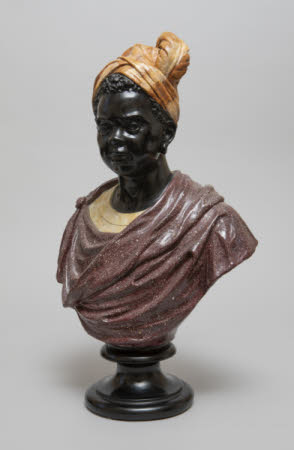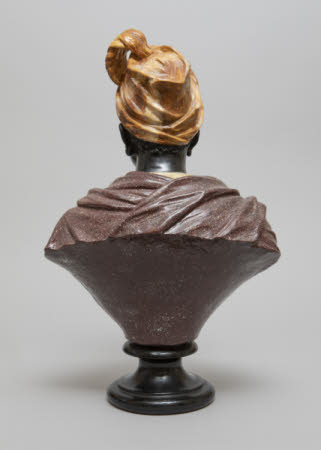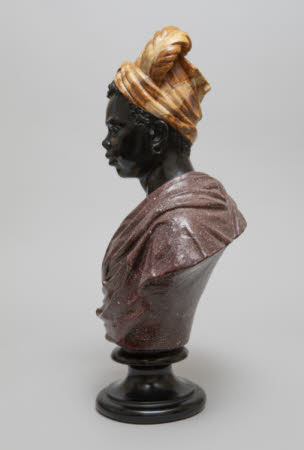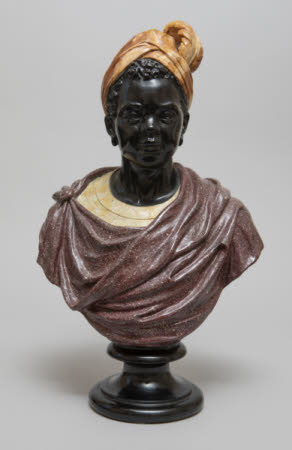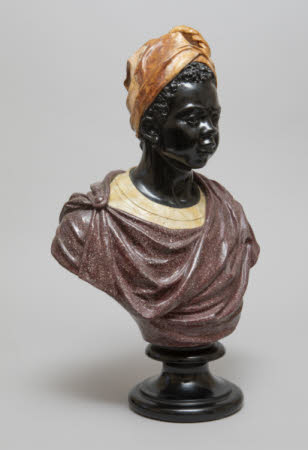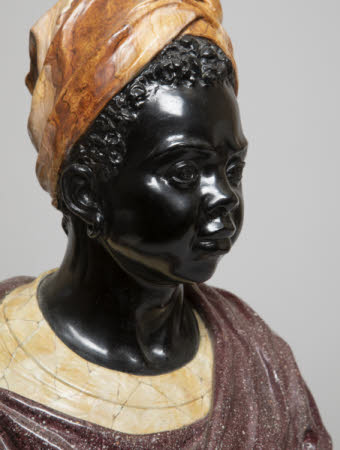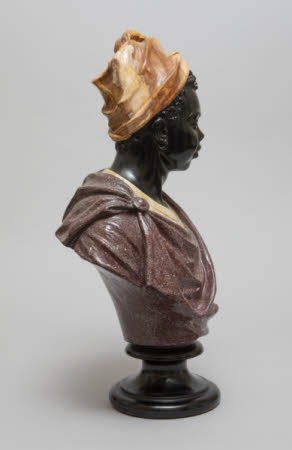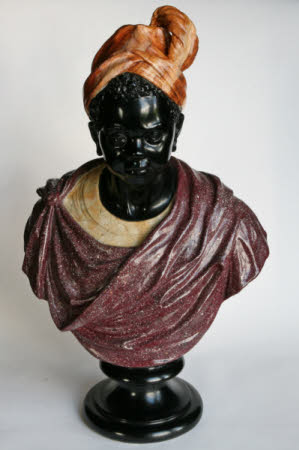A bust of a woman
probably Italian School
Category
Art / Sculpture
Date
c. 1800 - c. 1899
Materials
Ebonised wood, porphyry, giallo, and alabaster or onyx
Measurements
560 x 330 mm
Place of origin
Italy
Order this imageCollection
Mottisfont, Hampshire
NT 770325
Summary
Ebonised wood, porphyry, giallo, and alabaster or onyx, a bust of a woman, Italian or Continental School, probably 19th century. A polychrome bust of an African woman, the body of ebonised wood, the classical drapery of porphyry, the tunic of giallo marble, the turban of alabaster or onyx. Mounted on a turned ebonised socle.
Full description
This bust belongs to a type of European decorative sculpture depicting unnamed African peoples in highly stylised, often stereotypical ways. So-called ‘moor’ or ‘blackamoor’ busts were mainly produced in Venice and Rome from about the 17th to the 19th century, however examples have also been traced to Northern European workshops. They were usually conceived as pairs depicting a man and a woman, produced using polished black marble or patinated bronze for the body, and different types of coloured decorative stone for clothing and accessories. The Mottisfont bust is a fairly standard example of the type, the sitter generically depicted. The general motif has existed in European decorative art since the medieval period but developed into a recognisable type in Italy, chiefly Venice, in the 17th century. It is to be found across western material culture from ceramics to silverware, heraldry to jewellery, furniture to sculpture, architecture, painting and print (e.g. NT 413922, 452977, 936871, 118826, 129512, 802613, 1139940). Such objects became popular in Europe as the transatlantic slave trade gained momentum, and as European colonial powers expanded their territories in Africa and Asia. Designed for elite domestic settings, the ‘blackamoor’ was displayed with other luxury goods purchased, imported, and collected from across the globe. The ‘moor’ – an ill-defined term applied to peoples of Muslim and/or African heritage – was revived in Renaissance art and later by artists like Nicolas Cordier (1567-1612) and Melchoir Barthel (1625-72). Between 1607 and 1612, Cordier sculpted the first full-length statue of a ‘moor’ using an antique torso as a base, completing the black marble figure with alabaster, lapis lazuli and coloured marble (Louvre, MR 303). Later in the century Barthel sculpted colossal Atlas figures in black and white marble for the Tomb of Doge Giovanni Pesaro in the Frari, a model bust for that scheme now in the Saint Louis Art Museum (inv.no. 54:1990). For notable later examples, see: Wallace Collection, London, inv.nos. S17–18 (Italian School, busts of an African man and woman, polychrome marble, c. 1650); Royal Collections Trust, RCIN 1396 (John Nost, bust of an African man, polychrome marble, c. 1700); Victoria & Albert Museum, London, inv.no. 451-1869 (Venetian School, bust of a black youth, polychrome marble, c. 1700-50); and Sotheby’s, London, Treasure, Aristocratic Heirlooms, 6 July 2010, lot 6 (Italian School, the Mentmore busts, polychrome marble, c. 1715). Alice Rylance-Watson 2020
Provenance
Purchased by CEM (MW) from Redmile
Makers and roles
probably Italian School, sculptor
References
Levenson, Yang, Gonzales-Day 2015: Cyra Levenson, Chi-ming Yang, Ken Gonzales-Day, ‘Haptic Blackness: The Double Life of an 18th-century Bust’, British Art Studies, I, 2015 Shohat 2018: Ella Shohat, 'The Spectre of the Blackamoor', The Comparatist, vol. 42, October 2018, pp. 158-88.
